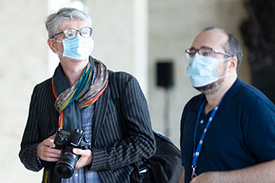Journalism and Civil Society Activism in a Post–COVID-19 World: Risk Assessment

For the updated Risk Assessment, click here.
How can journalists mitigate COVID-19’s challenges and seize the situation’s opportunities?
Since the outbreak of the COVID-19 pandemic, we have all been navigating a new operating environment. To not only cope with the effects of the pandemic but also seize the opportunities it presents, IREX’s Securing Access to Free Expression (SAFE) Initiative conducted an in-depth risk assessment to explore the pandemic’s potential impact on SAFE, IREX, civil society groups, communities, and other actors.
This assessment identifies challenges and opportunities for media and marginalized groups and provides recommendations from the perspective of projects, civil society organizations, and donors.
Findings: Journalists face heightened risks as the pandemic disproportionately affects marginalized groups
As journalists spend more time online and become targets of increased digital attacks, the need for digital literacy will become even more important.
Economic hardships, political instability, and lockdowns expose media to high-risk scenarios and create various mental health challenges that are likely to continue even after the pandemic ends. The pandemic’s economic, political, and social challenges disproportionately affect marginalized groups. Authority figures are increasingly treating marginalized groups as scapegoats.
However, the transition to virtual spaces creates an opportunity for technological innovations that could expand the audience for news media and engage people who have otherwise been excluded. Moreover, the pandemic could lead to heightened awareness about physical safety issues, crisis preparedness, and mental health.
As economic downturns and media outlets’ financial difficulties continue, more journalists will work as freelancers. This transition poses initial challenges but also offers profound opportunities for the sector as a whole by providing space for new voices and perspectives.
Recommendations: How journalists, civil society groups, and activists can seize opportunities that the pandemic brings
- As the transition to online spaces continues, programs should prioritize marginalized groups’ needs and make virtual activities as accessible as possible for people with disabilities, those living in rural areas, indigenous communities, women, and other marginalized groups.
- Organizations should update how they provide support to media so that training, emergency funds, and other support options better meet the needs of people with lower digital literacy and people with unstable internet connections.
- Projects and organization should audit internally available knowledge and skills and fill “gaps” through professional development, hiring, or network building.
- Projects and organizations with an established presence should mobilize resources and coordinate collaborative responses to emerging challenges (for example, through preventive measures in promoting mental health).
Photo: "43rd Session of the Human Rights Council" by UN Geneva, CC BY-NC-ND 2.0